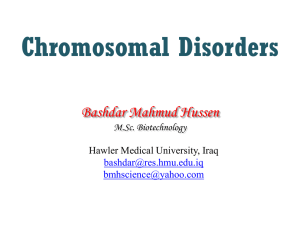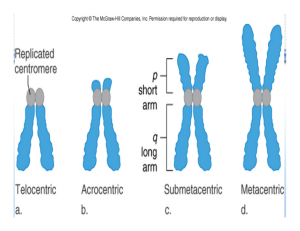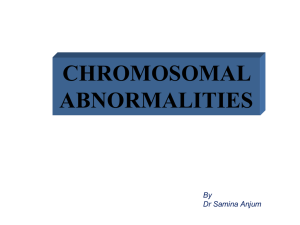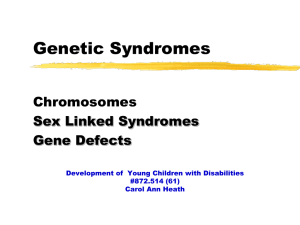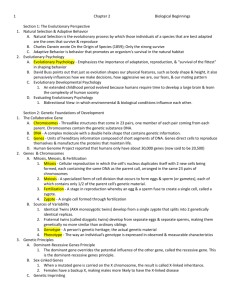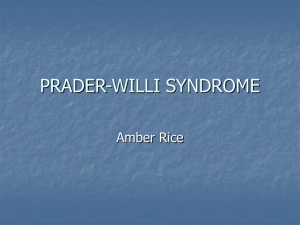chapter15activity
advertisement
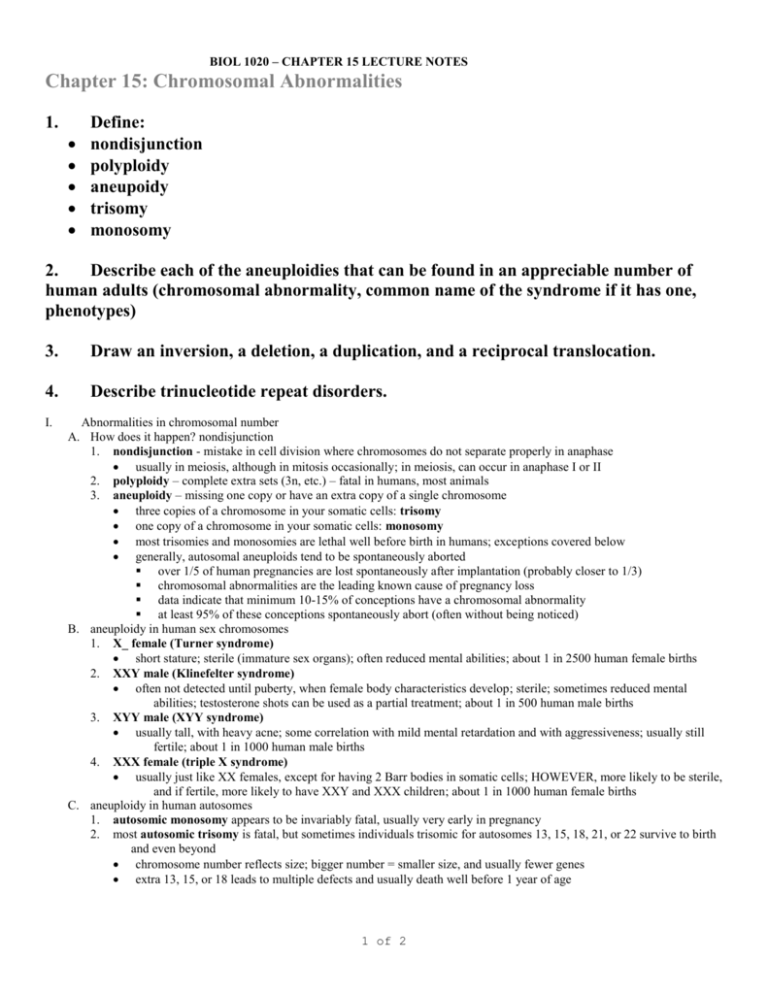
BIOL 1020 – CHAPTER 15 LECTURE NOTES Chapter 15: Chromosomal Abnormalities 1. Define: nondisjunction polyploidy aneupoidy trisomy monosomy 2. Describe each of the aneuploidies that can be found in an appreciable number of human adults (chromosomal abnormality, common name of the syndrome if it has one, phenotypes) 3. Draw an inversion, a deletion, a duplication, and a reciprocal translocation. 4. Describe trinucleotide repeat disorders. I. Abnormalities in chromosomal number A. How does it happen? nondisjunction 1. nondisjunction - mistake in cell division where chromosomes do not separate properly in anaphase usually in meiosis, although in mitosis occasionally; in meiosis, can occur in anaphase I or II 2. polyploidy – complete extra sets (3n, etc.) – fatal in humans, most animals 3. aneuploidy – missing one copy or have an extra copy of a single chromosome three copies of a chromosome in your somatic cells: trisomy one copy of a chromosome in your somatic cells: monosomy most trisomies and monosomies are lethal well before birth in humans; exceptions covered below generally, autosomal aneuploids tend to be spontaneously aborted over 1/5 of human pregnancies are lost spontaneously after implantation (probably closer to 1/3) chromosomal abnormalities are the leading known cause of pregnancy loss data indicate that minimum 10-15% of conceptions have a chromosomal abnormality at least 95% of these conceptions spontaneously abort (often without being noticed) B. aneuploidy in human sex chromosomes 1. X_ female (Turner syndrome) short stature; sterile (immature sex organs); often reduced mental abilities; about 1 in 2500 human female births 2. XXY male (Klinefelter syndrome) often not detected until puberty, when female body characteristics develop; sterile; sometimes reduced mental abilities; testosterone shots can be used as a partial treatment; about 1 in 500 human male births 3. XYY male (XYY syndrome) usually tall, with heavy acne; some correlation with mild mental retardation and with aggressiveness; usually still fertile; about 1 in 1000 human male births 4. XXX female (triple X syndrome) usually just like XX females, except for having 2 Barr bodies in somatic cells; HOWEVER, more likely to be sterile, and if fertile, more likely to have XXY and XXX children; about 1 in 1000 human female births C. aneuploidy in human autosomes 1. autosomic monosomy appears to be invariably fatal, usually very early in pregnancy 2. most autosomic trisomy is fatal, but sometimes individuals trisomic for autosomes 13, 15, 18, 21, or 22 survive to birth and even beyond chromosome number reflects size; bigger number = smaller size, and usually fewer genes extra 13, 15, or 18 leads to multiple defects and usually death well before 1 year of age 1 of 2 BIOL 1020 – CHAPTER 15 LECTURE NOTES extra 22 is much like extra 21 (Down syndrome, covered below), but usually more severe, with shorter life expectancy 3. trisomy 21 (Down syndrome): the only autosomal trisomy condition in humans that allows an appreciable number of individuals to survive to adulthood found in about 1 in 750 live births; a phenotypically identical condition occurs that is not due to a true trisomy (it involves a chromosomal translocation, covered later) traits include abnormal facial appearance, high likelihood of mental retardation (degree varies considerably), and increased likelihood of developing leukemia and Alzheimer’s disease likelihood of a child being born with Down syndrome increases with the age of the mother rate is as high as 1 in 16 live births for mothers age 45 and over at conception; not completely clear why the odds go up so dramatically, likely a combination of factors; nondisjunction is more common in eggs than sperm; appears that spontaneous rejection of aneuploid pregnancies is more common in younger women II. Abnormalities in chromosomal structure: chromosomal rearrangements and fragile sites A. in addition to nondisjunction errors, there can be errors in homologous chromosome pairing and in crossing over; these produce chromosomal rearrangements 1. reciprocal translocation – nonhomologous chromosomes pair and exchange parts (if only one gets new material, this is just called a translocation) can lead to deletions (loss of genetic material) and duplications (extra copies of genetic material) somewhat common in humans is a translocation of chromosome 21 to chromosome 14 results in only 45 chromosomes in body cells of carrier (has one chr 14, one chr 21, one 14/21 = normal phenotype), but that individual has a high chance of producing offspring that are essentially trisomy 21 (with one chr 14, two chr 21, and one 14/21) this is called translocation Down syndrome, accounting for about 3% of all phenotypic Down syndrome individuals 2. inversion – part of a chromosome is “flipped” relative to the normal gene sequence; can lead to deletions and duplications 3. deletion causes include losses from translocations, crossovers within an inversion, and unequal crossing over can also be caused by breaking without rejoining, usually leading to large deletions small deletions are less likely to be fatal; large deletions are usually fatal – but always, there is variation based on what genes are lost some medium-sized deletions lead to recognizable human disorders several syndromes have been described that correspond to deletions of certain chromosomal regions; most commonly found in live births in humans is deletion of the short arm of chr 5 called cri du chat (cat’s cry) syndrome found in about 1 in 50,000 live births surviving infants have a distinctive cry, severe mental retardation, and shortened lifespan 4. duplication causes include extras from translocations, crossovers within an inversion, and unequal crossing over again, amount makes a difference, with larger duplications more likely to be fatal, but there is variation based on what genes are duplicated duplications also provide raw material for genetic evolution; for example, there are many pseudogenes in humans that are “inactivated” duplicates B. fragile sites 1. some chromosomes have regions that are poorly connected to the rest of the chromosome; the “poor connection” is often a string rich in CGG or CGC repeats, and is inherited like a gene breaks from these fragile sites lead to loss of genetic material 2. human X can have such a site (fragile X syndrome) effects center on decreased mental capacity more prominent effects in males than females one of the trinucleotide repeat disorders: normally 5-55 CGG repeats diseased individuals have 200-1300 repeats like many trinucleotide repeat disorders, the repeat number may increase from one generation to the next 3. other fragile sites may play a role in cancer 2 of 2

